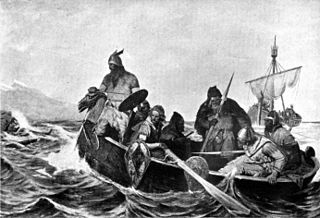When the Vikings burst out of their homelands starting in the 8th century, they raided, fought and settled in many parts of Europe and Russia, but they also took off on voyages of discovery across the Atlantic Ocean. They moved into Scotland and Ireland and most of the Atlantic Islands—Shetland, Orkney and the Hebrides. Vikings soon settled in the Faroe Islands as well and later discovered Iceland through a sailing mishap. Over the next two centuries, Viking explorers settled in Iceland, Greenland and Vinland, in what is now Newfoundland.
Iceland
Norwegian Vikings first discovered Iceland. The first was Naddod, who was blown off course sailing from Norway to the Faroe Islands in 861. He called the new island Snowland. Naddod returned to Norway and told people of his discovery. Six years later, Floki Vilgerdarson was the first Viking to set out for Iceland and find it. Floki gave the island its present name of Iceland. However, it wasn’t until 870 that people arrived to settle in Iceland.
When Harald Fairhair strong-armed Norway under his control, many people fled—some settled in Scotland, Ireland, Orkneys and Faroe Islands and Iceland. A Norwegian chieftain, Ingolfur Arnarson brought his family to Iceland in 874, settling on the southwest peninsula in a place he called Reykjavik or Cove of Smoke. Many other families from Norway, Scotland and Ireland followed. The Icelandic sagas and Landnamabok or Book of the Settlements, written 200 years later, describes the early settling of Iceland. For the next 60 years, settlers came and picked out arable land to farm.
Greenland
Icelanders discovered and settled in Greenland starting in the 980s. Erik the Red, an adventuresome and belligerent man, was exiled from Iceland for killing a man. During his three year-exile, Erik explored the southwest coast of Greenland. When he returned to Iceland, he bragged of the good land he had found, calling it Greenland to attract settlers. Icelanders settled in two main areas, the Eastern Settlement and the Western Settlement.
Farming was difficult, but settlers were able raise livestock and enough grain to feed them. Greenland was able to export furs, wool, sheep, whale blubber and walrus ivory. Due to the advance of the Little Ice Age, however, the colony declined during the 14th century. Life had become too hard, shipping too difficult due t o growing ice. By 1408, all the settlers were gone.
Vinland, North America
A trader named Bjarni Herjolfsson was sailing to Greenland. He was blown off course and sighted lands to the west. He successfully completed his journey to Greenland where he described his accidental find to Leif Ericson, son of Erik the Red. Circa A.D. 1000, Leif and a crew sailed across 1,800 miles across open sea, following Bjarni’s description of his voyage. The Greenlanders made a small settlement in the land they called Vinland. Due to hostile natives that the Vikings called skraelings, the settlement eventually failed.
In the 1960s, a Norse settlement was found at L’Anse aux Meadows in Newfoundland by an archeologist Anne Stine Ingstad and her husband Helge. Whether this is the Viking settlement mentioned in various sagas is still in dispute, but archeology proves the Vikings discovered North America 500 years before Christopher Columbus.
This article is part of our larger selection of posts about The Vikings. To learn more, click here for our comprehensive guide to The Vikings.
Cite This Article
"Viking Explorations and Settlements: Iceland, Greenland and Vinland" History on the Net© 2000-2024, Salem Media.
April 24, 2024 <https://www.historyonthenet.com/viking-explorations-and-settlements-iceland-greenland-and-vinland>
More Citation Information.

